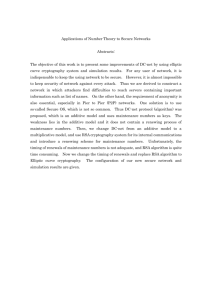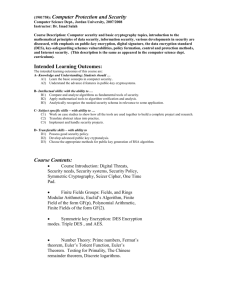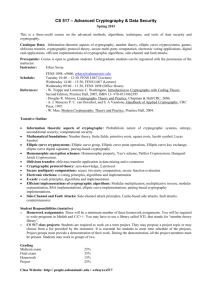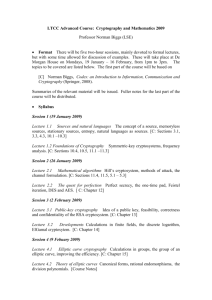DNA Cryptography
advertisement
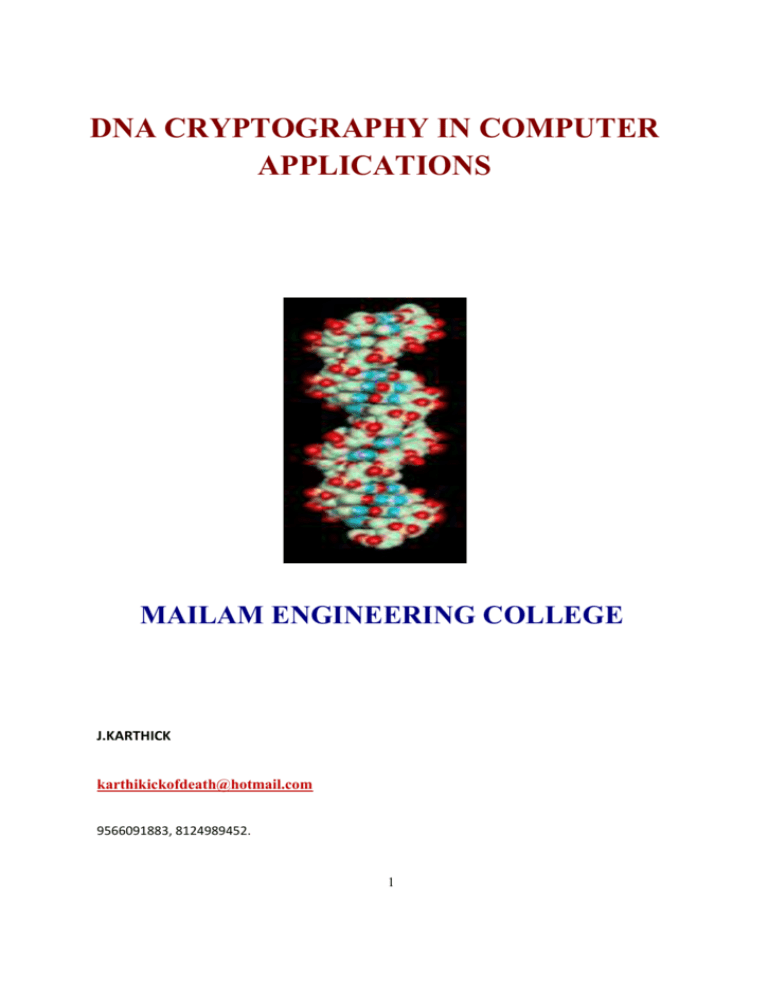
DNA CRYPTOGRAPHY IN COMPUTER APPLICATIONS I MAILAM ENGINEERING COLLEGE J.KARTHICK karthikickofdeath@hotmail.com 9566091883, 8124989452. 1 ABSTRACT The DNA cryptography is a new and very curve cryptography) used in this project connecting promising direction in cryptography research. DNA with can be used in cryptography for storing and message. Finally we compare the performance of transmitting the information, as well as for DNA computing based elliptic curve cryptography computation. Although in its primitive stage, DNA with RSA algorithm. cryptography is shown to be very effective. DNA computing technique to encrypt INTRODUCTION Currently, several DNA computing algorithms are cryptography, As the rapidly development of information cryptanalysis and steganography problems, and technology, the security of information and they are very powerful in these areas. However, the communication becomes more and more important. use of the DNA as a means of cryptography has Cryptographic techniques is the kernel of whole high tech lab requirements and computational information security technology. Recent research limitations, intensive has considered DNA as a medium for secure data extrapolation means so far. In this project, we do transmission and for ultra- compact information not intend to utilize real DNA to perform the storage. DNA was proposed for computation by cryptography process; rather, we will introduce a Adleman in 1994.After that many approaches have new cryptography method based on central dogma been investigated. It has been shown that DNA of molecular biology. Since this method simulates computing was some critical processes in central dogma, it is a currently hard to resolve (intractable) and could pseudo DNA cryptography method. The theoretical work more faster than electronic computer. After analysis and experiments show this method to be Adleman solved the Hamilton Path Problem using a efficient in computation, storage and transmission; combinatorial and it is very powerful against certain attacks. Thus, computational problems were calculated by DNA this method can be of many uses in cryptography, computer. The DNA computing could solve many such as an enhancement in security and speed to the problems, like NP complete problem,0-1 planning other cryptography methods. There are also problem, SAT problem, integer planning problem, extensions and variations to this method, which optimal problem , graph theory, cryptography , have database , etc. For DNA computing, an important proposed for as enhanced quite well some as security, the labor effectiveness and applicability. The RSA algorithm and ECC (elliptic suitable for some problems molecular method, many hard problem is how to deduce.The probability of mistakes happen during reaction to make the code 2 better works. Much experimentation have shown applications. The goal is to transmit a message that the reliability of this new ways can be between a sender and improved significantly through suitable encoding hacker is unable to understand it. Encryption is strategy. the process of scrambling the plaintext using a A single strand DNA consist of four different base nucleotides, including adenine (A), thymine (T), cytosine (C) and guanine (G). After attached to deoxyribose, those nucleotides could be strung together to generate long sequences. Each single string will paired up with a complementary string to be a double helix. The pair up just occurs under the Watson-Crick complement rule. The rule is, A only pairs with T and G only pairs with C. Also the strand can be separated by kinds of chemistry and physics ways. The dissociated strand separate from each other, but it cannot breaking the chemical bonds of the nucleotides together We usually use different DNA molecule structure to solve different problem. The majority of DNA molecules used in known algorithm and a secret key. The output is a sequence of characters known as the ciphertext. Decryption transforms computing have hairpin DNA molecules and is the reverse process, which the encrypted message back to the original form using a key. The goal of encryption is to prevent decryption by an adversary who does not know the secret key. An unbreakable cryptosystem is one for which successful cryptanalysis is not possible. Such a system is the one-time-pad cipher. It gets its name from the fact that the sender and receiver each possess identical notepads filled with random data. Each piece of data is used once to encrypt a message by the sender and to decrypt it by the receiver, after which it is destroyed. DNA computing are single strands and double strands, but some of them were used in DNA receiver such that an 3.3 Mapping the plaintext: DNA Cryptosystems Using Random One-Time-Pads plasmid DNA molecules One-time-pad encryption uses a codebook of random data to convert plaintext to ciphertext. Since the codebook serves as the key, if it were predictable (i.e. adversary Data security and cryptography are critical aspects of conventional computing and may also be important to possible DNA database not random), then could guess the algorithm an that generates the codebook, allowing decryption of the message. No piece of data from the codebook should ever be used more than once. If 3 it was, then it would leak information about the Encryption occurs by substituting each plaintext probability DNA word with a corresponding DNA cipher distribution of the plaintext, increasing the efficiency of an attempt to guess word. the message. This class of cryptosystems using long DNA a secret random segments, each of which cryptosystems one-time-pad are the only known to be absolutely unbreakable. The mapping is implemented using a pad that consisting of many specifies a single plaintext word to cipher word mapping. The plaintext word acts as a hybridization site for We will first assemble a large one-time-pad in the form of a DNA strand, which is randomly assembled from short oligonucleotide sequences, the binding elongated. of a primer, which is then This results in the formation of a plaintext-ciphertext word-pair. then isolated and cloned. These one-time-pads An ideal one-time-pad library would contain a will be assumed to be constructed in secret, and huge number of pads and each would provide a we further assume that specific one-time-pads perfectly are shared in advance by both the sender and plaintext words to cipher words.The plaintext is receiver of the secret message. This assumption to be mapped with the nucleotides. The mapping requires initial communication of the one-time- formation is given in the table. Use of mapping is to pad between sender and receiver, which is encode the original message. For example if the facilitated by the compact nature of DNA.The plaintext is ‘think’ for each character it will encode decryption is done by similar methods. with corresponding DNA Cryptosystem Using random mapping from nucleotides given in Table 3.1. Table 3.1: Nucleotides Substitution 'A A substitution one-time-pad system uses a ciphertext. The = 'K CGA' plaintext binary message and a table defining a random mapping to unique, input = 'U = CTG' AAG' ‘0 = ACT ' 'B = CCA' 'L = TGC' 'V = CCT' '1 = ACC' 'C = GTT' 'M = TCC' 'W =CCG' '2 = TAG' 'D = TTG' 'N = TCT' '3 = GAC' strand is of length n and is partitioned into plaintext words of fixed length. The table maps all possible plaintext strings of a fixed 'X = CTA' length to corresponding ciphertext strings, such 'E = GGC' 'O that there is a unique reverse mapping. GGA' 4 = 'Y AAA' = '4 = GAG' 'F = GGT' 'P = GTG' 'Z = CTT' 'G = TTT' 'Q = AAC' '''= ATA' '5 = AGA' '6 = TTA' differently. The one is used for encryption and the corresponding key must be used for decryption. The RSA algorithm is the most common and 'H = CGC' 'R = TCA' ', = TCG' '7 = ACA' 'I = ATG' 'S = ACG' '. = GAT' '8 =AGG'; 'J = AGT' 'T = TTC' ': = GCT' '9 = GCG' proved asymmetric key cryptographic algorithm but the RSA algorithm is based on the mathematical fact which is easy to get and multiply large prime numbers together. the private and public keys in RSA are based on extremely large prime numbers The original message is the plaintext. The plaintext is mapped with the nucleotides. After the mapping P&Q(two large prime numberare choiced process is done it is converted to numbers. Then the public key cryptography algorithm is followed to N=P*Q(Calculate N) encrypt and decrypt the message. Here the public key cryptography algorithms RSA and ECC are Public Key:E & Private key:D used to to recover the original plaintext in the early period cryptography used to be executed by using Encryption:CT=PTE mod N manual techniques. Now the basic frame of performing cryptography has remained just about CT to receiver the same as past.most importantly, computer has accompolish these cryptographic algorithms and Decryption:PT=CTD mod N functions,thus making the ways a lot faster and secure. For telecommunication and data, cryptography is necessary over any untrusted medium,which includes any networks, particularly Elliptic curve cryptography (ECC) is an approach to public-key cryptography based on the algebraic structure of elliptic curves over finite fields any systems.cryptography not only protects data from being stolen or attracted, but it also can be Public-key cryptography is based on the used for authentication for users. intractability of certain mathematical problems. Early public-key systems, such as the RSA Public-key cryptography has been considered to be the most significant development in cryptography recently years. It is also called asymmetric cryptography,two different keys are algorithm, are secure assuming that it is difficult to factor a large integer composed of two or more large used 5 prime factors. For elliptic-curve-based protocols, it is assumed that finding the discrete logarithm of a random elliptic curve element with respect to a publicly-known base point is unfeasible. The size of the elliptic curve determines the difficulty of the problem. It is believed that the same level of security afforded by an RSA-based Private key :n A; Public key :PA = n A*G Receiver key generation: Private key :n B ;Public key :PB = n B*G Elliptic Curve Encryption system with a large modulus can be achieved with a Elliptic curve cryptography can be used to encrypt much smaller elliptic curve group. Using a small plaintext messages, M , into ciphertexts. The plaintext group message M is encoded into a point PM reduces storage and transmission form the finite requirements. set of points in the elliptic group, Ep (a, b). The first step For current cryptographic purposes, an elliptic consists in choosing a generator point, G ∈ Ep (a, b), such curve is a plane curve which consists of the points that the smallest value of n such that nG = O is a very satisfying the equation large prime number. The elliptic group Ep (a, b) and the generator point G are made public. Each user select a private key, nA < n and compute along with a distinguished point at infinity, denoted . (The coordinates here are to be chosen from a fixed finite field of characteristic not equal to 2 or 3, or the curve equation will be somewhat more complicated.) This set together with the group operation of the elliptic group theory form an the public key PA as: PA = nA G. To encrypt the message point PM for Bob (B), Alice (A) choses a random integer k and compute the ciphertext pair of points PC using Bob’s public key PB : PC = [(kG), (PM + kPB )] Abelian group, with the point at infinity as identity element. The structure of the group is inherited After receiving the ciphertext pair of points, PC , Bob from the divisor group of the underlying algebraic multiplies the first point, (kG) with his private key, variety. nB , and then adds the result to the second point in the ciphertext pair of points, (PM + kPB ):which is The entire security of ECC depends on the ability to compute a point multiplication and the inability to the plaintext point, corresponding to the plaintext message M . compute the multiplicand given the original and product points. Security of ECC Sender key generation: 6 The cryptographic strength of elliptic curve encryption computational complexity of 1.6 × 1028 lies in the difficulty for a cryptanalyst to determine the (still with the Pollard ρ method). MIPS-years secret random number k from kP and P itself. The fastest method to solve this problem (known as the elliptic curve logarithm problem ) is the Pollard ρ CONCLUSION factorization method [Sta99]. This method simulates some critical processes in The computational complexity for breaking the elliptic central dogma, it is a pseudo DNA cryptography curve cryptosystem, using the Pollard ρ method, is method. The theoretical analysis and experiments 3.8×1010 MIPS-years (i.e. millions of instructions per show this method to be efficient in computation, second times the required number of years) or an elliptic storage and transmission; and it is very powerful curve key size of only 150 bits [Sta99]. For comparison, the against certain attacks.Thus, this method can be of fastest method to break RSA, using the General many uses in cryptography, such as an Number Field Sieve Method to factor the composite enhancement in security and speed to the other interger n into the two primes p and q, requires 2 × 108 cryptography methods. There are also extensions MIPS-years for a 768-bit RSA key and 3 × 1011 MIPS- and variations to this method,which have enhanced years with a RSA key of length 1024. security, effectiveness and applicability. References [1] L.M. Adleman, Molecular computation of solutions to combinational problems. Science, (1994), 266(4), pp. 1021-1025. [2] R.J. Lipton, Using DNA to solve NP-complete problems. Science, (1995), 268(4), pp. 542-545. [3] R.S. Braich, N. Chelyapov, and C. Johnson, Solution of a 20-Variable 3-SAT Problem on a DNA Computer, Scienc (2002),296, pp. 499- If the RSA key length is increased to 2048 bits, the General Number Field Sieve Method will need 3 × 1020 MIPS-years to factor n whereas increasing the elliptic 502. [4]D.Boneh,C.Dunworth,andR.Lipton,BreakingDE S using a molecular computer. In Proceedings of curve key length to only 234 bits will impose a DIMACS workshop (1995),pp. 37-65. 7 on DNA computing, [5] L.M.Adleman,P.Rothemund,andS.Roweis,On applying molecular computation to the date encryption strands in DNA based computers, In Proceedings of 2ndDIMACS Workshopon DNABasedComputers, (1996), pp. 28-48. [6] C.T.Celland,V.Risca,andC.Bancroft,Hiding messages in DNA microdots. Nature, (1999), 399, pp.533-534. [7] J.P.L. Cox. Long-term data storage in DNA. Trends Biotechnol. (2001), 19, pp. 247-250. [8] G.Z.Cui,Y.L.Liu,andX.C.Zhang,NewDirectionof Data Storage: Technology, DNA Computer Molecular Storage Engineering and Applications, (2006), 42(26), pp. 29-32. [9] J. Chen. A DNA-based, biomolecular cryptography design. Circuits and Systems ISCAS apos, (2003), pp. 822-825. [10] M. Amosa, G. Paun, and G. Rozenbergd, Topics in the theory of DNA computing, Theoretical Computer Science, (2002), 287, pp. 3-38. 8
